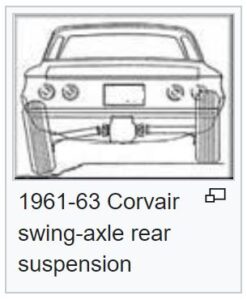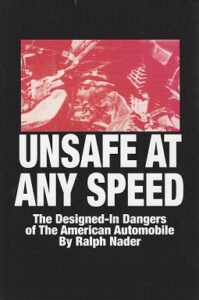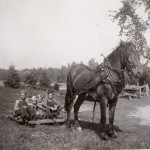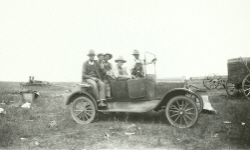transportation
 When the automobile was invented, everyone rightly thought it was going to be the “end all, beat all” of transportation inventions. In many ways, it probably was just that…at that time anyway, but as with any form of transportation, when it’s very new, it’s also very flawed. By its very nature, and invention is often trial and error. On November 30, 1965, a 32-year-old lawyer named Ralph Nader saw something in the automobile that caused him to become very concerned…concerned enough to write a book about his findings. Nader called his book Unsafe at Any Speed: The Designed-In Dangers of the American Automobile. Just the title of the book is enough to worry the thinking consumer…or maybe what would have been the “overthinking” consumer.
When the automobile was invented, everyone rightly thought it was going to be the “end all, beat all” of transportation inventions. In many ways, it probably was just that…at that time anyway, but as with any form of transportation, when it’s very new, it’s also very flawed. By its very nature, and invention is often trial and error. On November 30, 1965, a 32-year-old lawyer named Ralph Nader saw something in the automobile that caused him to become very concerned…concerned enough to write a book about his findings. Nader called his book Unsafe at Any Speed: The Designed-In Dangers of the American Automobile. Just the title of the book is enough to worry the thinking consumer…or maybe what would have been the “overthinking” consumer.
Still, the book became a best-seller right away. It also triggered the passage of the National Traffic and Motor Vehicle Safety Act of 1966…seat-belt laws in 49 states…all but New Hampshire. It also triggered a number of other road-safety initiatives. The original automobile really did have some serious safety flaws, and while a lot of people would argue that the seatbelt doesn’t prevent death in accidents, the reality is that it prevents many of those deaths, and the ones that seatbelts don’t prevent, are so bad that nothing would have prevented death.
These days, Ralph Nader is known for his role in national politics, running unsuccessfully for President of the United States four times…running with the Green Party in 1996 and 2000, the Reform Party in 2004, and as an independent in 2008. In each campaign, Nader said he sought to highlight under-reported issues and a perceived need for electoral reform. He received nearly three million votes during his 2000 candidacy, but also stirred controversy over allegations that his campaign helped Republican candidate George W Bush win in a highly contested election against Democratic candidate Al Gore.
Nader’s book placed the automobile in a negative light for the 50 years prior to the releases of the book, saying  that “the automobile has brought death, injury, and the most inestimable sorrow and deprivation to millions of people.” His real complaint was that technology existed at that time to make cars safer, but automakers had little incentive to use them. He thought that the automakers skipped the important steps that could have brought about a much safer vehicle. He wrote that on the contrary, “the gigantic costs of the highway carnage in this country support a service industry,” meaning doctors, lawyers, police officers, morticians, with no real plans to change things and “there is little in the dynamics of the automobile accident industry that works for its reduction.”
that “the automobile has brought death, injury, and the most inestimable sorrow and deprivation to millions of people.” His real complaint was that technology existed at that time to make cars safer, but automakers had little incentive to use them. He thought that the automakers skipped the important steps that could have brought about a much safer vehicle. He wrote that on the contrary, “the gigantic costs of the highway carnage in this country support a service industry,” meaning doctors, lawyers, police officers, morticians, with no real plans to change things and “there is little in the dynamics of the automobile accident industry that works for its reduction.”
Nader’s book brought to light some of the harsh truths, or rather serious flaws, about and in cars and car companies that auto-safety advocates had known for some time, and seemingly done nothing about. Nader pushed hard against the automakers, and in 1956, at a series of Congressional hearings on traffic safety, doctors and other experts lamented the “wholesale slaughter” on American highways. Safety measures had all but been ignored, and that year, nearly 40,000 people were killed in cars, with no sign of a decrease in numbers on the horizon. If the consumers wanted the much-needed safety features, they could pay extra for a Ford with seatbelts and a padded dashboard, but very few did. It was estimated that only 2% of Ford buyers took the $27.00 seatbelt option. The auto industry not only made it more costly to get the safety features, but downplayed the importance of it.
In his book, Nader particularly ranted against the Chevy Corvair, a sporty car with a swing axle and rear–mounted engine that was introduced in 1959, saying that the car epitomized the triumph of “stylistic  pornography over engineering integrity.” The swing axle made the rear end unstable, causing it to “tuck under during turns and skid or roll over much more frequently than other cars did.” As it turned out, a 1972 government study vindicated the Corvair, finding that it was just as safe as any other car. I couldn’t say one way or another, but Nader called that study “rigged.” Nevertheless, the damage was done. The Corvair became an icon of dangerous, even deadly design, which was later proven to e the case. The last one rolled off the assembly line in 1969. I suppose the auto industry is a heavily funded group, and it would be easy to “fix” the numbers to say what they wanted to say.
pornography over engineering integrity.” The swing axle made the rear end unstable, causing it to “tuck under during turns and skid or roll over much more frequently than other cars did.” As it turned out, a 1972 government study vindicated the Corvair, finding that it was just as safe as any other car. I couldn’t say one way or another, but Nader called that study “rigged.” Nevertheless, the damage was done. The Corvair became an icon of dangerous, even deadly design, which was later proven to e the case. The last one rolled off the assembly line in 1969. I suppose the auto industry is a heavily funded group, and it would be easy to “fix” the numbers to say what they wanted to say.
Nader’s book mobilized a mass movement. Armed with the truth, ordinary consumers banded together to demand safer cars and better laws. When consumers take a stand, things can, and do happen. Today, seat belts, air bags, anti-lock brakes and other innovations are standard features in almost every new car. I don’t know what kind of a politician Ralph Nader was or is, but in this one thing anyway, he did something good.
 As airplanes became an accepted form of transportation, people began to consider traveling further and further. Of course, those first airplanes could never have made the flight across the ocean, but these days planes fly that far with ease. Still, someone had to be brave enough to take that first flight across the ocean. Someone had to trust their plane enough to make the attempt. British aviators John Alcock and Arthur Brown decided to be the first to make that leap when they made the first non-stop transatlantic flight in June 1919. Their plane was a modified First World War Vickers Vimy bomber. They flew from Saint John’s, Newfoundland to Clifden, Connemara, County Galway, Ireland. Like most accomplishments, the competition was fierce, and there had to be a reward for the winner. The Secretary of State for Air, Winston Churchill, presented them with the Daily Mail prize for the first crossing of the Atlantic Ocean by airplane in “less than 72 consecutive hours”. A small amount of mail was carried on the flight, making it the first transatlantic airmail flight. The two aviators were awarded the honour of Knight Commander of the Most Excellent Order of the British Empire a week later by King George V at Windsor Castle.
As airplanes became an accepted form of transportation, people began to consider traveling further and further. Of course, those first airplanes could never have made the flight across the ocean, but these days planes fly that far with ease. Still, someone had to be brave enough to take that first flight across the ocean. Someone had to trust their plane enough to make the attempt. British aviators John Alcock and Arthur Brown decided to be the first to make that leap when they made the first non-stop transatlantic flight in June 1919. Their plane was a modified First World War Vickers Vimy bomber. They flew from Saint John’s, Newfoundland to Clifden, Connemara, County Galway, Ireland. Like most accomplishments, the competition was fierce, and there had to be a reward for the winner. The Secretary of State for Air, Winston Churchill, presented them with the Daily Mail prize for the first crossing of the Atlantic Ocean by airplane in “less than 72 consecutive hours”. A small amount of mail was carried on the flight, making it the first transatlantic airmail flight. The two aviators were awarded the honour of Knight Commander of the Most Excellent Order of the British Empire a week later by King George V at Windsor Castle.
As with any record, there is always room for improvement. The first flight took place with two people on board, so on Ma 21, 1927, at age 25, Charles Lindbergh went from being an unknown United States Air Mail pilot, to world fame instantly, by making his Orteig Prize winning nonstop flight from Long Island, New York to Paris. He covered the 33½ hour, 3,600 miles alone in a single-engine Ryan monoplane called the Spirit of Saint Louis.  The plane was build for this flight. This was the first solo transatlantic flight, and the first non-stop flight between North America and mainland Europe. I wonder what he was thinking as he flew for 33½ hours alone over the ocean. He had to keep himself awake, and on course. There was no one else to do it. Most of us have a hard time staying awake for more than 17 or 18 hours, much less 33½ hours. It was an amazing feat, and one for which the fame he gained was well deserved.
The plane was build for this flight. This was the first solo transatlantic flight, and the first non-stop flight between North America and mainland Europe. I wonder what he was thinking as he flew for 33½ hours alone over the ocean. He had to keep himself awake, and on course. There was no one else to do it. Most of us have a hard time staying awake for more than 17 or 18 hours, much less 33½ hours. It was an amazing feat, and one for which the fame he gained was well deserved.
As with any record, someone had to beat it or improve on it or change it in some way. The record held until May 21, 1932, when Amelia Earhart became the first woman to make a solo air crossing of the Atlantic Ocean, from Newfoundland to Ireland. As with Charles Lindbergh, I wondered how Amelia stayed awake for all those hours, and what she was thinking as she flew along…alone for all those hours. I’m sure there was excitement in the extreme, but I’m sure she was weary after the flight was over too.
 I love the way that kids can be so inventive. They have some great ideas, and while they can’t always make their ideas into reality by themselves, with a little help, you will find that they will get it done. No one really knows who created the skate board, but it was designed by attaching wheels from a pair of skates to create a surfing effect. That way they could surf, even if the ocean waves weren’t cooperating. A good idea if you ask me.
I love the way that kids can be so inventive. They have some great ideas, and while they can’t always make their ideas into reality by themselves, with a little help, you will find that they will get it done. No one really knows who created the skate board, but it was designed by attaching wheels from a pair of skates to create a surfing effect. That way they could surf, even if the ocean waves weren’t cooperating. A good idea if you ask me.
Then there were the go carts. Made from things in the garage, they were usually wooden and used the wheels off of a tricycle or some such item. Of course, I would expect that the brakes took a little more figuring. I’m sure those first go carts ended in crashes more than they didn’t, and eventually someone found a way to make them stop. If they hadn’t, I think they would have stopped riding them after a while, since there is only so much crashing a person can take before they decide that this just isn’t worth the ride.
What I find very interesting, is the types of things the kids back in my parents’ day did when they wanted to create a new mode of transportation. It would appear to me that they were trying to make a sleigh, and they had no wheels…or snow, for that matter. I would imagine that it was a bumpy ride to say the least, but them these boys don’t seem to mind that thought much. I’m quite sure they were very proud of their new contraption. It also makes me think of the many kids these days, who have done their very best to hook their dog up to a wagon and have the dog pull them around. While that might work ok with a dog, I’m not so sure I would want to try it with a horse, but then, I don’t know that particular horse, and they surely did. It is quite possible that the horse knew the typical antics these boys pulled, and like any pet, who loves it’s master, the horse was gentle enough to go along with the new fangled vehicle that was hooked up to it.
 I have often wondered what it must have been like when the first automobiles were starting to make their way onto the scene. I think that both the people and the horses, or other animals used to pull wagons, must have just about freaked out. People had no idea that such things were possible back then. And the horses…well, after the noise scared the daylights out of them, they probably took off like rockets…maybe inspiring future inventions.
I have often wondered what it must have been like when the first automobiles were starting to make their way onto the scene. I think that both the people and the horses, or other animals used to pull wagons, must have just about freaked out. People had no idea that such things were possible back then. And the horses…well, after the noise scared the daylights out of them, they probably took off like rockets…maybe inspiring future inventions.
I think that the first thought on peoples’ minds would be to distrust this new fangled contraption. They would wonder if it was going to run away like horses sometimes did, only there would be no reasoning with it or pulling on the reigns to stop it. Or, would it blow up…after all, it was a machine. Or, could it be dangerous…going out of control or rolling over. Maybe they thought all these things, but it’s quite possible that they simply thought that this new fangled machine was an unnecessary luxury…a waste of money…or maybe just for the rich people, who always seemed to be too extravagant anyway. People were used to being conservative with their supplies and their money.
Change is often a difficult thing to accept, and I can imagine that people like my great grandparents were pretty unsure of some of the new inventions that were showing up. They were used to their old ways, and it just seemed very extravigant to buy into these new things. Yes, change is hard to accept, but once we get used to it, many inventions turn out to be not only good things, but in many ways, such as with the automobile, they are destined to become something so necessary to life in this world, that it would be difficult to live without them.

I like to think that my grandparents were among those who accepted change easily. I see them as people who had open minds, and who saw change for what it was…necessary. I like to think of them as the kind of people who wanted to be living in the present, with all it had to offer. Still, I have to wonder what they might think of some of the new fangled contraptions we have today, such as the cell phone, lap top, Kindle, iPhone, and iPad. If you suddenly put those things into the mid-1800’s…wouldn’t that just blow your mind.
 Few things give as much pleasure as the excitement of a child when they receive a gift that so obviously excites them. And for a toddler, few things are more exciting than receiving a pony. Ponies have changed over the years, but how much kids love them hasn’t. How is it that kids just seem to instinctively know that riding is fun. We don’t even have to tell them. They just know. I suppose they have watched us, or television, or other kids. Whatever it is, they learn the fun of the ride…on whatever form of transportation they can catch a ride on.
Few things give as much pleasure as the excitement of a child when they receive a gift that so obviously excites them. And for a toddler, few things are more exciting than receiving a pony. Ponies have changed over the years, but how much kids love them hasn’t. How is it that kids just seem to instinctively know that riding is fun. We don’t even have to tell them. They just know. I suppose they have watched us, or television, or other kids. Whatever it is, they learn the fun of the ride…on whatever form of transportation they can catch a ride on.
Christopher received his pony for his first or second Christmas, and he was so excited. He had big eyes anyway, but when he was excited…well, wow!! His eyes in this picture were so big!! Christopher always had great expressions and this was one of the best. In fact, this is one of his favorite pictures. Those big eyes are such a draw.
Christopher and Shai, his cousin, being born one day apart and Amy babysitting Christopher, made them best friends from the start. Naturally they spent a lot of time together when their mom’s weren’t working too, so Shai had her opportunity to come over and play at Christopher’s house.  On this particular day, they were taking turns on the pony, and both were equally excited about it. The adventure was on, and they were going places. No one knew where except them, but they knew.
On this particular day, they were taking turns on the pony, and both were equally excited about it. The adventure was on, and they were going places. No one knew where except them, but they knew.
Ponies just seem to have that effect on kids…or people for that matter. We all take great pleasure in them. Real or toys, they remind us of a simpler time and a bit of freedom. We can imagine the wind in our hair as we ride free across the plains. Sometimes if we try really hard, we can imagine a trip back in time to the days of the old west. Of course, for a two year old, it’s really all about the ride.
 Though she has definitely outgrown that stage, my younger daughter, Amy, was every bit a blond when she was little. She was forgetful and lost things we never found…in her room!! But while she was pretty ditsy back then, she has turned into very capable, responsible young woman. That is not what my story is about, however. There are two stories about Amy that come to mind today.
Though she has definitely outgrown that stage, my younger daughter, Amy, was every bit a blond when she was little. She was forgetful and lost things we never found…in her room!! But while she was pretty ditsy back then, she has turned into very capable, responsible young woman. That is not what my story is about, however. There are two stories about Amy that come to mind today.
When Amy learned to walk, she, like all kids, took those first tottering little steps…then within days, she decided that walking was just not for her!!! She ran from that time forward, which I might add, her son, Caalab, would follow in later on. She was always in a hurry. And it didn’t take her long to find another interesting way to speed things up in the area of transportation. Yes, I know what you are thinking, behind the wheel of a car…right? Well, you’re wrong. Amy decided that it took too long to walk down the hallway. Or maybe it just wasn’t enough fun. Just as soon as she figured out how, her chosen method of getting down the hallway was to somersault!! From the moment she started that, until she was in about third grade, I don’t think she ever walked down the hall. It was entertaining, to say the least.
But, on an even funnier note…one day when Amy was 2 years old and learning to dress herself, she gathered up the clothes she wanted to wear and brought them into the kitchen to get dressed. She was doing pretty good with it. Everything was going on the right way, right side out, front in the right place, and so forth. I was proud of her for doing such a good job.
Then she started looking around. Under the table, on top of the table, behind her…obviously she thought she brought something from her bedroom that she couldn’t find. So I said, “What are you looking for?” To which she answered, “My shirt!!” Try as I might, I just couldn’t help but laugh!!! I said, “Amy!!! You have it on!!” She looked down…very shocked, I might add, and said, “Oh, hahahahahahaha!!!”
Never a dull moment in our house…lol!!

